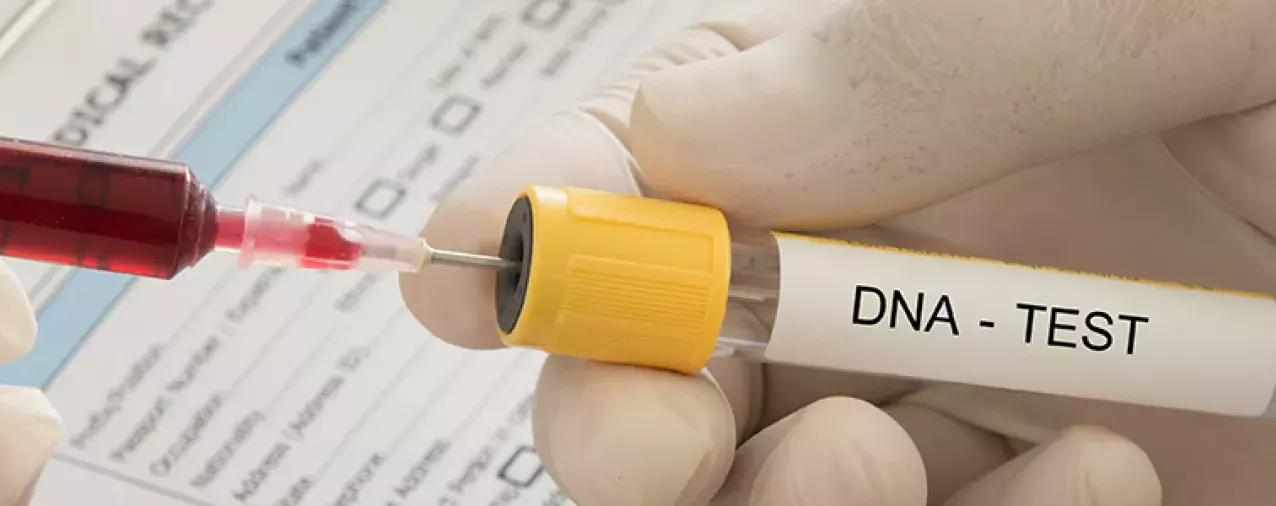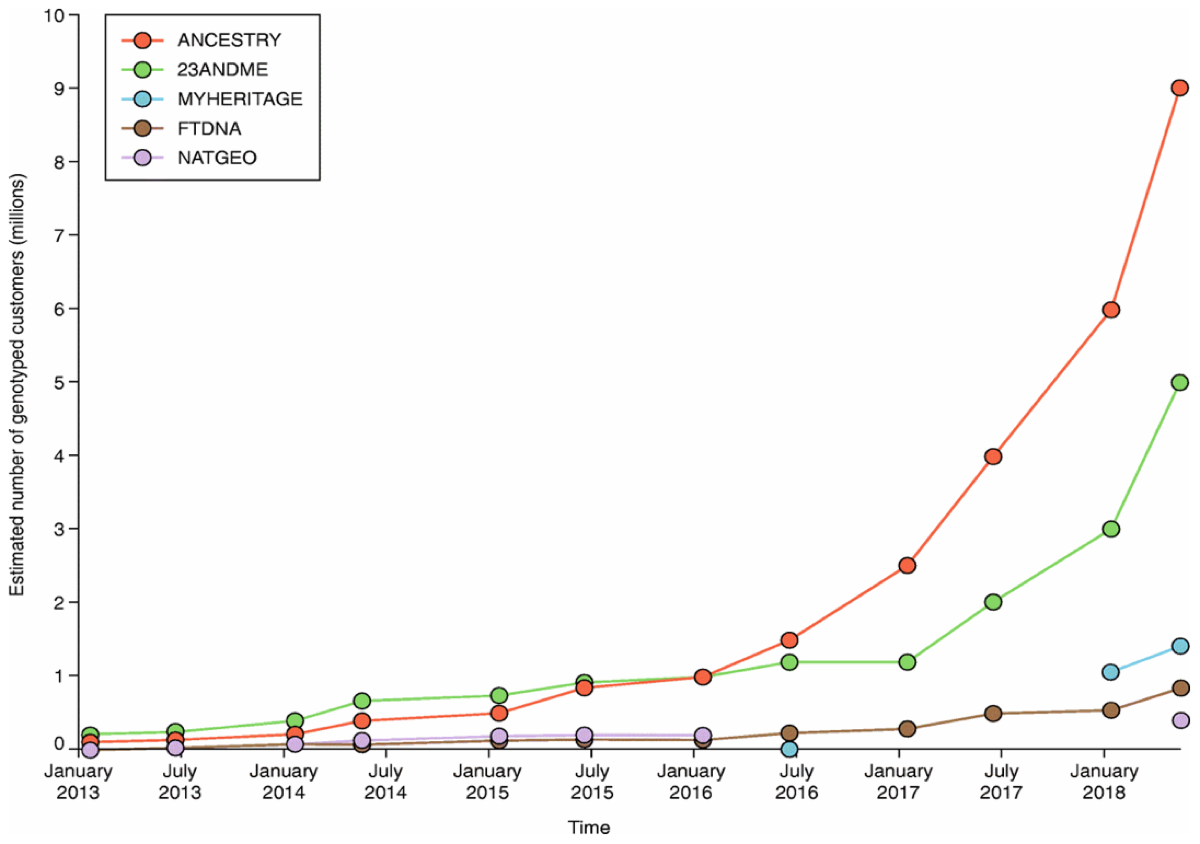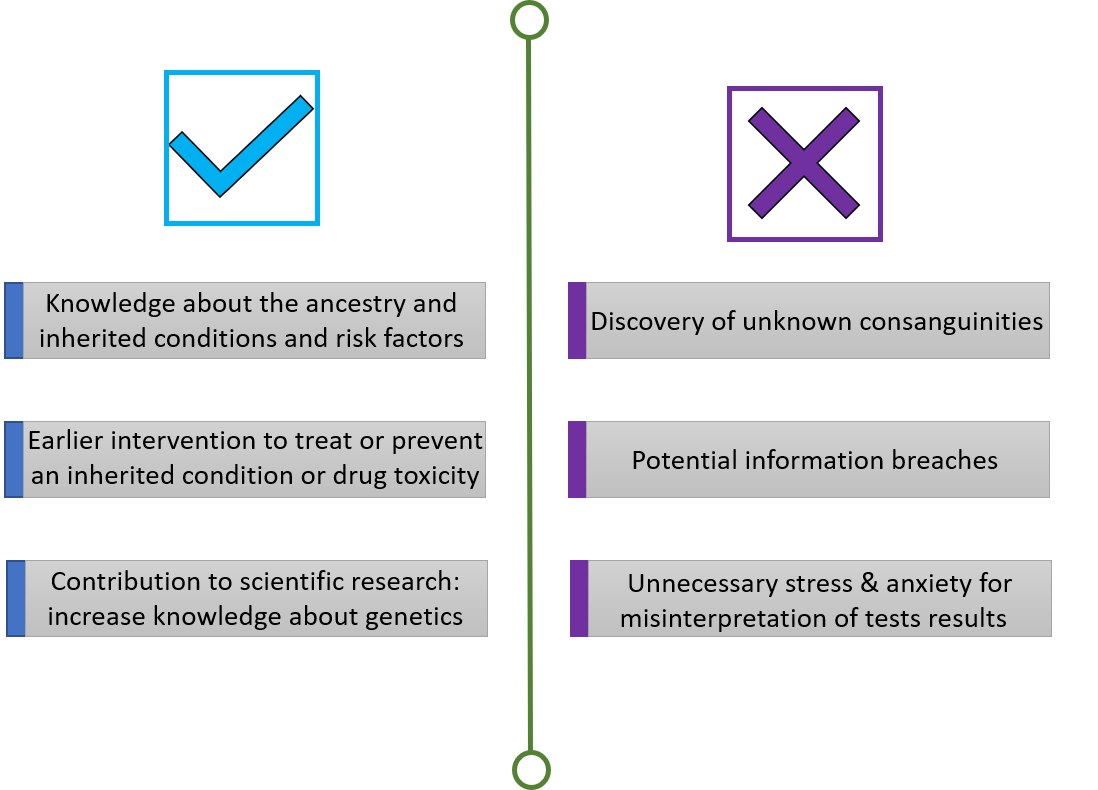Genomics: Insight

The most common questions about DTC genetic testing…and answers!

Direct-to-consumer (DTC) genetic testing like Ancestry.com, and 23andMe among others are undoubtedly gaining popularity and curiosity among the general population. The number of consumers of DTC genetic testing is increasing exponentially (Figure 1). Consumers have the opportunity to glimpse into insights from their own DNA without the intervention of a medical professional or interaction with health insurance companies. Although the availability of DTC genetic testing may allege benefits to prevent and diagnose disease, current and potential customers have many questions about how such tests work, associated benefits and information privacy. Here are several frequently asked questions about DTC genetic testing.

What is DTC-genetic testing?
DTC genetic test is a method by which your DNA is collected and analyzed to identify specific variations also known as single nucelotide polymorphisms (SNPs). These variations are useful to determine ancestry, trace family trees (genealogy), identify disease risk, predisposition to adverse drug events, physical traits, and wellness-related traits. Detecting such variations depends on the reference genome used for comparison within the analysis. Usually, these tests are sold as kits that contain either a device to deposit your saliva (spit) or a swab to brush the inside of your cheeks to obtain buccal (cheek) cells which will be used to extract the DNA. The prices of some DTC genetic tests can be as low as $59.
DTC genetic tests is a method by which your DNA is collected and analyzed to identify specific variations also known as single nucelotide polymorphisms (SNPs)
What types of DTC-genetic testing are available?
Most of the currently available DTC testing provide information about ancestry and health-related information. For example, Ancestry.com, My Heritage and NatGeo (Geno 2.0) provide information exclusively regarding ancestry. Specifically, 23andMe is a broader test that provides information on ancestry, predisposition to certain disease risk, physical traits (e.g., earlobe type, cleft chin, early hair loss, red-hair and wake-up time), and wellness-related traits (e.g., alcohol reaction, deep sleep, and lactose intolerance).
How DTC genetic tests can trace my ancestry?
This may be a complex question since some DTC genetic tests (e.g., Ancestry.com) can create the false expectation of reconstructing your ancestral lineage based on records from previous generations. It is not possible to trace back your ancestral lineage to determine if you are a distant cousin of Prince Harry and Prince William of England. However, scientific findings have revealed the migration and breeding patterns of ancient populations across the world. These patterns are used to determine your ancestry.
When a DTC genetic test determines your ancestry, it is estimating in your DNA the genomic contributions from your ancestors that belonged to different ethnic groups
When a DTC genetic test determines your ancestry, it is estimating in your DNA the genomic contributions from your ancestors that belonged to different ethnic groups. For example, a Hispanic or Latino individual can be 10% Native American, 30% African, and 60% European, but this can be different for each individual. A new population evolves when different isolated populations breed, this is known as admixture. The ancestral contributions of the previous example emerge from the admixture that occurred between Europeans, Africans, and Natives during the Spanish colonization more than 500 years ago. Although databases from DTC genetic testing do not hold DNA of ancestors from previous generations, scientists within the research and development teams use the admixture patterns of the populations that matches your DNA to determine your ancestry.
For Ancestry.com, the estimation of ancestry is possible by using DNA from 10 million samples from more than 350 regions in the world that are available within their database[2]. In the case of 23andMe, they use a reference dataset from more than 11,000 individuals whose genomes reflect the populations that existed before transcontinental migrations[3]. As you can see, each company has a different strategy, but the mechanism to identify your ancestry boils down to compare your DNA with other DNA sequences that are available in each company’s databases. If each genome has over 3 billion building blocks (known as nucleotides or bases), what are the scientists looking at between samples? This is when SNPs become handy. Scientists are comparing the pattern of SNPs between you and other samples from known ethnic groups. Each population or ethnic group has specific SNP patterns which are distinguishing features from other populations. And your genome holds the SNP patterns from each ancestral population that gave origin to your population; this is what your report reflects.
How DTC genetic tests can determine my disease risk?
Diseases that are caused by changes in the DNA can be identified mainly using information from family studies or other genetic studies from unrelated individuals. Such changes in the DNA could be SNPs that are different from those used to inform ancestry, and may cause an impact in our physiology. Other types of changes in the DNA can also predispose humans to certain diseases. The location of these changes in the DNA has been cautiously identified and the impact has been thoroughly evaluated before establishing an association with a disease. The scientists from DTC genetic testing companies use that information available in the literature and public databases to report your disease risk. However, it is worth noting again that such established associations are most representative as determined by the population groups from which studies of the specific disease risk were evaluated.
What benefits do I get from DTC-genetic testing to my health?
First, it depends on your reasons to obtain a DTC genetic test. If you want to know your ancestry because you are curious about your origin, this testing will fulfill your curiosity. On the other hand, if you want to know your risk to certain diseases early on, the use of DTC genetic testing has limitations worth considering.
The most important leap for DTC genetic tests will be having clinical utility. Clinical utility refers to the ability of the test to improve health outcomes when compared to the standard-of-care. Currently, the U.S. Food and Drug Administration (FDA) does not consider DTC genetic testing as a method to provide medical advice or diagnose any health condition. However, FDA released authorization to test genetic variants of BRCA associated with cancer that occur more frequently in Ashkenazi Jewish women[4]. The limitation is that a positive result needs confirmation with a test from a certified pathology laboratory. A positive result may save lives and promote follow-up visits to a physician for earlier monitoring and surveillance. On the other hand, a negative result does not exclude the possibility of having BRCA-related cancer.
Additionally, DTC genetic testing is not considered a medical practice, therefore the companies are not allowed to provide information about the medical implications of the results or give any medical advice. The customer should consider that this lack of information may create unnecessary stress and anxiety related to test reports. And, it is important for customers to educate themselves on these limitations.
Is it possible to bring my DTC genetic testing reports to my physician?
There is not a definite answer to this question. The only medical professionals that can interpret and provide information about DTC genetic tests are physicians but not every physician has the genomic literacy and expertise to discuss the report with their patients. This could be for a variety of reasons including the physician is unaware of the technology testing platform used and cannot speak to the validity and/or limitations of results. In fact, a small study conducted to determine the attitudes of physicians toward DTC genetic testing found that less than 30% of the participants reported having enough knowledge to help patients understand the results of DTC genetic test; this proportion increased to 73% after undergoing personal genetic testing[5].
What about information privacy?
Companies such as 23andMe and Ancestry.com assert that the customer has the power to determine if their individual data will be shared with other customers and/or research databases. Ancestry.com has a public database for those customers who consent to the release of their data. On the other hand, 23andMe does clearly state that genetic information is not disclosed to any public database, employer, or insurance companies. 23andMe further states that the customer can opt for discarding his/her biological sample (saliva). Nonetheless, the customer needs to consider that since DTC genetic testing is not under the definition of “Medical Practice”; therefore it is not fully protected by the Health Information Privacy and Portability Act (HIPPA)[6].

Should I do DTC genetic testing?
It is a personal choice. Everyone is entitled to have access to their own DNA information. On the other hand, consider the benefits that you will obtain, the downsides regarding your information privacy, and not to be overlooked, consider any ethical issues that could potentially arise from testing yourself or your family members[7, 8]. Finding unsuspected relatives or unknown adoptions are not uncommon with DTC genetic tests[9, 10].
References
[1]Khan R & Mittelman D. Consumer genomics will change your life, whether you get tested or not. Genome Biology. 2018; 19 (120).
[2]How does an AncestryDNA test work? Ancestry.com. Published November 30, 2016. Accessed August 15, 2019.
[3]FDA authorizes, with special controls, direct-to-consumer test that reports three mutations in the BRCA breast cancer genes.
[4]Haga, Susanne B et al. “Primary Care Physicians' Knowledge, Attitudes, and Experience with Personal Genetic Testing.” Journal of personalized medicine vol. 9,2 29. 24 May. 2019, doi:10.3390/jpm9020029.
[5]Seward B. Direct-to-Consumer Genetic Testing: Finding a Clear Path Forward Therapeutic Innovation and Regulatory Science. 2017. 52(4). P.482-488.
[6]Ancestry Composition: 23andMe’s State-of-the-Art Geographic Ancestry Analysis. Updated May 2018. Accessed August 15, 2019.
[7]The Washington Post. April 3, 2018. A woman says an Ancestry.com DNA test revealed her father-her parent’s fertility doctor. Accessed August 15, 2019.
[8]Reynolds M. UPI. August 14,2019. Family sues after DNA kit reveals fertility clinic secret. Accessed August 15, 2019.
[9]Heersink O. The Times. 'DNA doesn't lie': Siblings put up for adoption reunite in Region after learning of each other's existence via Ancestry.com Accessed August 19, 2019.
[10]Thorbecke C. ABC News. Father and son meet for the 1st time after Ancestry.com DNA test. Accessed August 15, 2019.
About the Author

Karla Claudio did her Ph.D. in Pharmacology from the University of Puerto Rico. Her dissertation research was focused in pharmacogenetics of warfarin. She has seven publications in the field of pharmacogenetics of admixed populations, including a chapter for the second edition of the book Pharmacogenomics. She is a member of the CYP2C expert panel of the Pharmagene Variation Consortium (PharmVar). Currently, she is doing her postdoctoral training in the field of psychiatric genomics at the University of Florida and enjoy doing all kind of scientific communication for non-scientists.